First Look Review: 2023 Chevrolet Colorado packs full-size torque in a mid-size pickup
Chevrolet is coming off a rather successful year of truck sales. The Silverado (with the help of its GMC Sierra sibling) beat the Ford F-series in retail sales. Deliveries of the midsize Colorado surged 20 percent, solidifying its second-place finish behind the dated (yet ever popular) Toyota Tacoma. Chevrolet is hoping to carry that momentum into 2023 with an all-new, third-generation Colorado pickup that boasts new sheet metal, an updated wheelbase, and a fresh powertrain.
At launch, Chevrolet is offering up only crew-cab, short-bed models—the most popular (and likely most lucrative) variant. Nobody at Chevrolet will admit that there are extended cab variants in the pipeline, but we wouldn’t be surprised if those follow in a year or two. The redesigned chassis pushes the front wheel wells forward to accommodate larger tires than in previous generations, something that the Z71 and Trail Boss trims take advantage of with 31-inch and 32-inch tires, respectively.
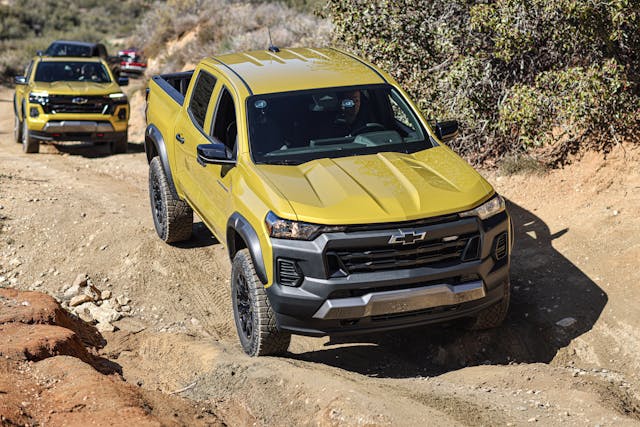
Chevrolet invited us to San Diego for a first drive of its new truck. We spent the bulk of our time behind the wheel in those mid-trim Z71 and Trail Boss models. Our route included miles on the highway, through town, on winding backroads, and a quick jaunt down some fire roads that had recently been slicked by rain.
On the first leg was in a Z71, painted Nitro Yellow Metallic. The options list included the Colorado’s Z71 Convenience Package II ($1625), bundling remote start, an eight-way power driver seat, tilt and telescoping steering wheel, wireless charging, heated seats, and an auto-dimming mirror. Also part of the II package is that a handy new “StowFlex” tailgate, featuring a lockable, water-tight storage compartment that is built in. The Z71 Convenience Package III ($1415) adds memory settings for the seat, heated steering wheel, rear seat armrests, leather upholstery, rear cross-traffic braking, blind zone steering assist, ventilated front seats, and rear park assist. The Technology Package ($950) gave our test truck adaptive cruise control, rear pedestrian alert, and HD surround vision cameras. Additional options included a power sliding sunroof ($1000), an advanced trailering package ($620), a premium audio system ($500), a spray-in bedliner ($475), and the Nitro Yellow paint ($395). All told, the window sticker indicated $49,660 out the door—not a small sum, but then again, with full-size trucks regularly cresting the $60,000 mark, that appears to be just a sign of the times. For bargain-conscious shoppers, the Work Truck starts at $30,695 including destination.
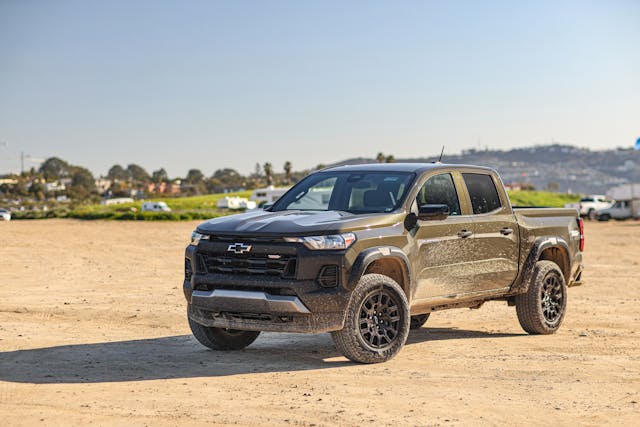
This generation of Colorado features more chiseled fenders and bedside flares—styling that’s echoed in the hood. The overall design is less fluid and more muscular-looking than the previous generation. The tweaked paneling helps Colorado better fit into the overall the Chevy truck lineup, carrying more of the machismo that permeates the light-duty and heavy-duty Silverados.
The interior of the third-gen Colorado is also new, with round HVAC vents on the far sides of the horizontal dash and an 11.3-inch touchscreen in the middle. All trim levels get the same-sized center screen, so even the Work Truck trim has a large display that uses a Google-based infotainment system that offers wireless Android Auto and Apple CarPlay connectivity. Most Colorados will ship with an 8-inch Driver Information Center (DIC) that can display engine vitals like oil temp, water temp, and transmission temp neatly around the sides of a prominent tachometer and digital speedometer. If you want an 11-inch screen ahead of the steering wheel, you’ll have to opt for a top-dog ZR2, or a GMC Canyon.
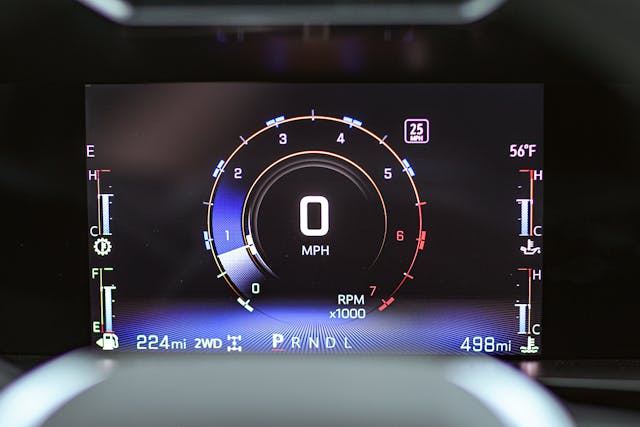
Several other optional screen settings for the DIC include a display for upcoming navigation prompts, a streamlined digital speedometer, and an off-road screen that displays pitch and roll angles, steering angle, and the status of the transfer case. These gauges are all neatly arranged and allow the driver to quickly scan vital information with ease. However, several of the customization options for this screen are selected through the touchscreen found in the center of the dash. (That’s where you’d find the trip odometer and fuel economy tracker, for example.) The interface responds quickly, but this is something that might take some getting used to, as plenty of that information was previously located in the driver information center. There are still knobs for the HVAC controls and volume, but the headlights are controlled through the screen. They get their own permanent icon, so turning on the fog lights or the automatic brights is just a tap away. Still, we can’t help but wonder what was so bad about those controls being actuated through a stalk behind the wheel or a dial just to the left of it.

Once behind the wheel, we found the Colorado a quiet, pleasant place to spend time. The center console wasn’t too intrusive and the seats offer quite a bit of fore and aft adjustment, as well as headroom, even when equipped with a sunroof. Tall drivers shouldn’t have much trouble finding a comfortable seating position without grazing the headliner. The seats were firm and comfortable, with the right mix of bolstering for corners and flat surfaces for long drives. Rear-seat passengers seem to have similar legroom as in the previous Colorado, which is to say plenty for most occupants unless the driver is particularly tall.
Specs: 2023 Chevrolet Colorado Z71
- Price (base/as-tested): $41,393 / $49,660
- Powertrain: 2.7-liter turbocharged inline-four, eight-speed automatic transmission
- Horsepower: 310 hp @ 5600 rpm
- Torque: 391 lb-ft @ 2000 rpm (optional 430 lb-ft at 3000)
- Layout: Four-wheel-drive, front-engine, five-seat midsize pickup
- Curb weight: 4250 pounds
- EPA-rated fuel economy (mpg), city/highway/combined: TBD
- Competitors: Toyota Tacoma, Ford Ranger, Nissan Frontier
Our first impression of the 2.7-liter turbo powerplant was that it sounds like a miniature semi truck, at least on the induction side. There’s a noticeable rush of spooling turbo sounds and not much exhaust noise until the throttle is really opened up. The torque from the 2.7-liter also feels like a turbodiesel, except with better throttle response. (Coincidentally, Chevy didn’t revive the 2.8-liter Duramax turbodiesel for the new Colorado because this new gas engine bested the diesel in torque and throttle response.) Around town or on the highway, adjusting speed to match traffic happens with just a nudge of the gas, allowing the turbo to spool up to provide more power. The redesigned eight-speed automatic transmission can and does stay in gear for these small demands in power and lets the engine quickly build boost. When a lot of power is demanded from aggressive throttle input, the transmission quickly kicks down one or more gears for a quick overtake or merging maneuver. All that power on tap at such low engine speed helps the Colorado achieve a 7700-pound tow rating, bringing it to the top of the mid-size class in that regard.
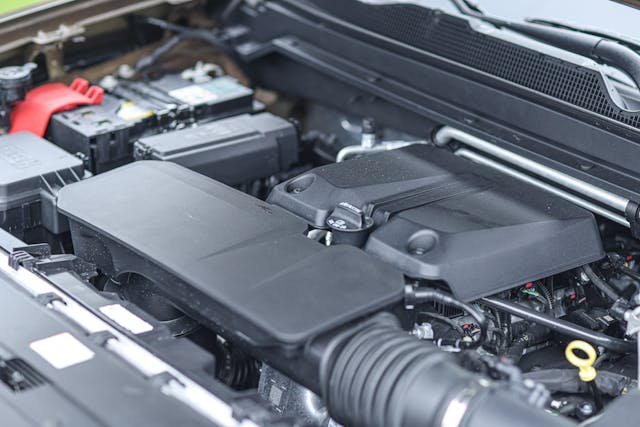
Even with the Trail Boss and Z71’s larger tires, on-road handling was sharp, and the mid-sized truck tackled curves smoothly. Off-road, both the Z71 and Trail Boss have improved ground clearance thanks to chunkier rubber and tucked-up shock mounts, making it easy to traverse ruts and rocks. We tried Hill Descent Control briefly and it helped us, along with the 360-degree cameras, to focus on picking the right line. The steering feel is properly weighted for a pickup, not overly boosted, while the brakes are assertive without being grabby. Dynamically, this feels a lot like the outgoing Colorado, which was one of the best-handling trucks in the segment. We were able to get comfortable behind the wheel immediately and focus on our biggest question about the new truck, its powertrain.
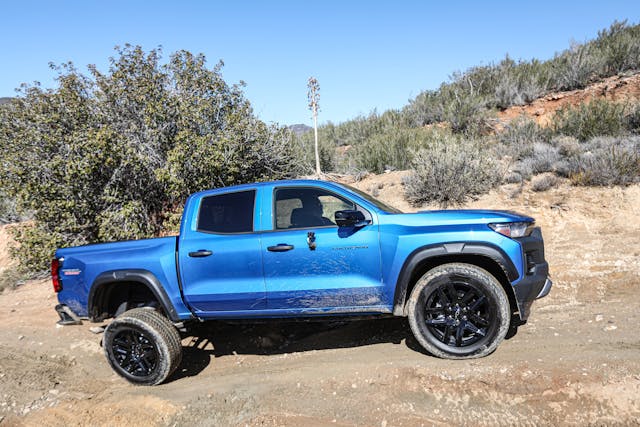
Despite sharing the same basic architecture, the Colorado actually offers two versions of the 2.7-liter four-pot, at three different output levels. The work truck trim comes with a low-boost version that produces 237 hp and 259 lb-ft of torque. It omits the piston oil squirters and a couple of noise insulators on the injector pump and injector rail to keep the price low, and it also comes with a different version of the eight-speed auto. The “Turbo Plus” engine that’s standard on LT, Trail Boss, and Z71 increases the output to 310 hp and 369 lb-ft of torque, thanks in part to those piston oil squirters that the base engine skips.
Standard on ZR2 and optional on all trim levels, the High Output version of the engine is basically the Turbo Plus setup but with a dealer-installed reflash of the computer that boosts torque to 430 lb-ft while the peak power remains unchanged. The tune makes it the most powerful gasoline engine in its class, tied with the Nissan Frontier, and it also nearly matches the torque of the Jeep Gladiator’s EcoDiesel V-6. (We took a bit of a deep dive into the 2.7-liter with Chevrolet engineer Kevin Luchansky last year, in case you’d like to learn more.)
We found that even the base work truck model feels plenty lively with “just” 237 hp, in large part thanks to its broad torque curve. The Turbo Plus is just more of the same excellent low-end and mid-range torque that makes 310 hp feel more like 350, as acceleration is linear and seemingly effortless. As much as we’d love to see and hear a 5.3-liter V-8 under the hood, we came away quite impressed with the turbo-four.
We didn’t get an opportunity to properly to check fuel economy at the pump, but the readout on the dash, which is measured in 50-mile increments by default, reported between 17.8 and 23.7 mpg, with the latter coming after a sedate 10-mile highway run pulled the average up a bit. The recorded best mileage from a previous driver was 23.9 mpg. We’d expect real-world mileage to be similar; those with a light foot on a long highway trip would be able to exceed those numbers rather easily.
Our brief time with the Colorado suggests that Chevrolet’s one-powertrain strategy will prove wise. Drivers will appreciate the ever-present torque and fuel economy of the 2.7-liter over the outgoing 3.6-liter naturally aspirated V-6. All of the adjustments to the new Colorado put Chevrolet in a great position to gain momentum in the mid-size market in 2023. With a new Ranger and Tacoma just on the horizon, the changes come not a moment too soon. We’ll have to wait and see how the ZR2 improves on what was our favorite off-road mid-sizer, but for now, the Z71 and Trail Boss have set the bar rather high.
2023 Chevrolet Colorado Z71 crew cab
Highs: Fantastic, flexible powertrain. Comfortable ride , improved off-road performance. Fuel economy seems promising.
Lows: Several features require onerous touchscreen interface. Work Truck/Trail Boss interior could use some color. Just one cab/bed configuration for now.
Takeaway: A solid contender in the mid-size market, the new Colorado has loads of capability built into every trim level.
***
Check out the Hagerty Media homepage so you don’t miss a single story, or better yet, bookmark it. To get our best stories delivered right to your inbox, subscribe to our newsletters.
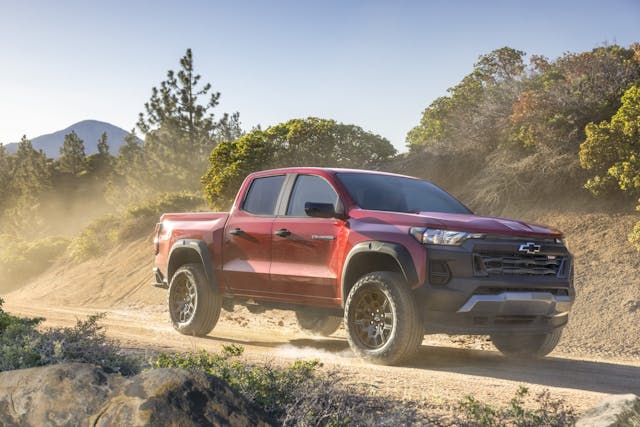
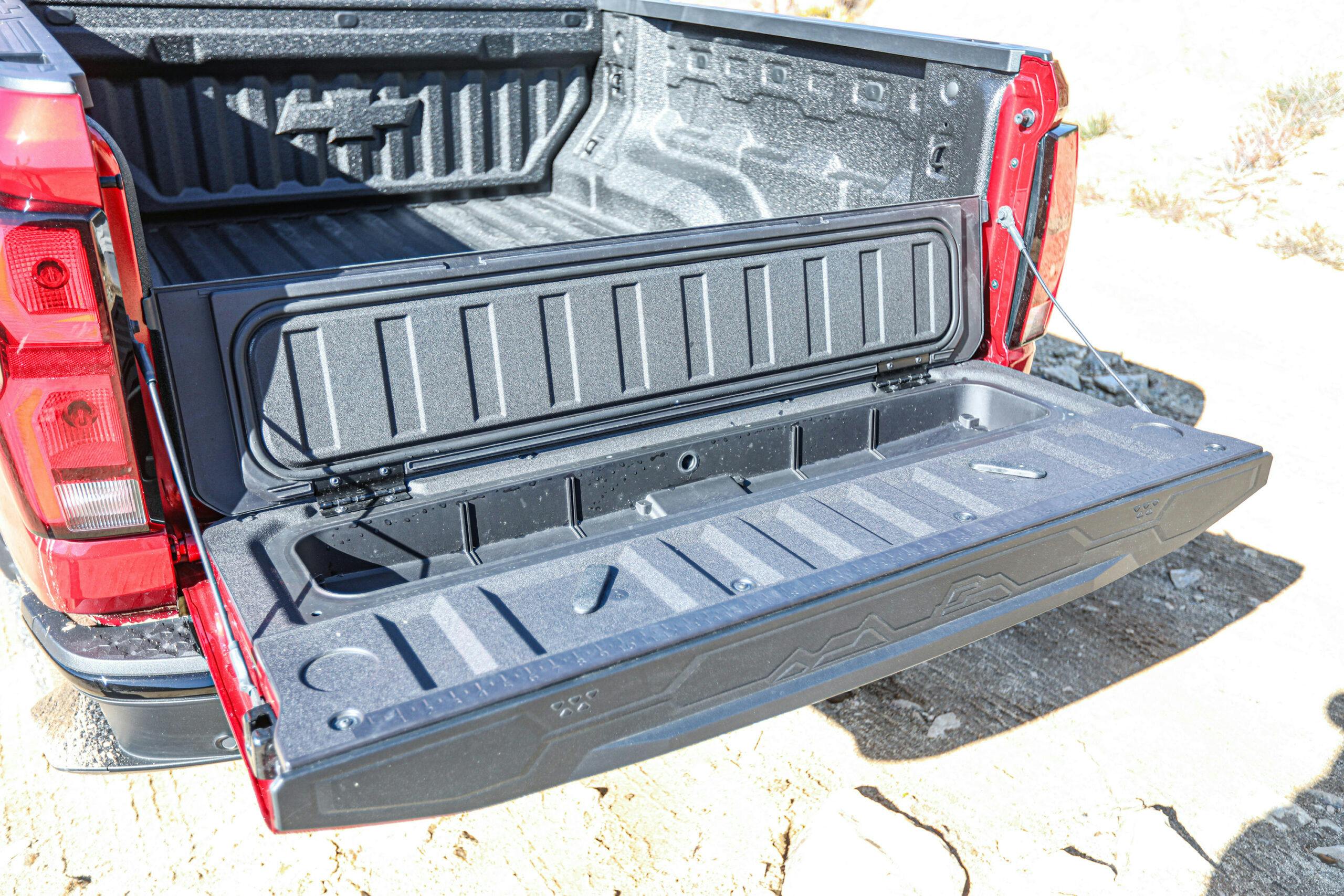
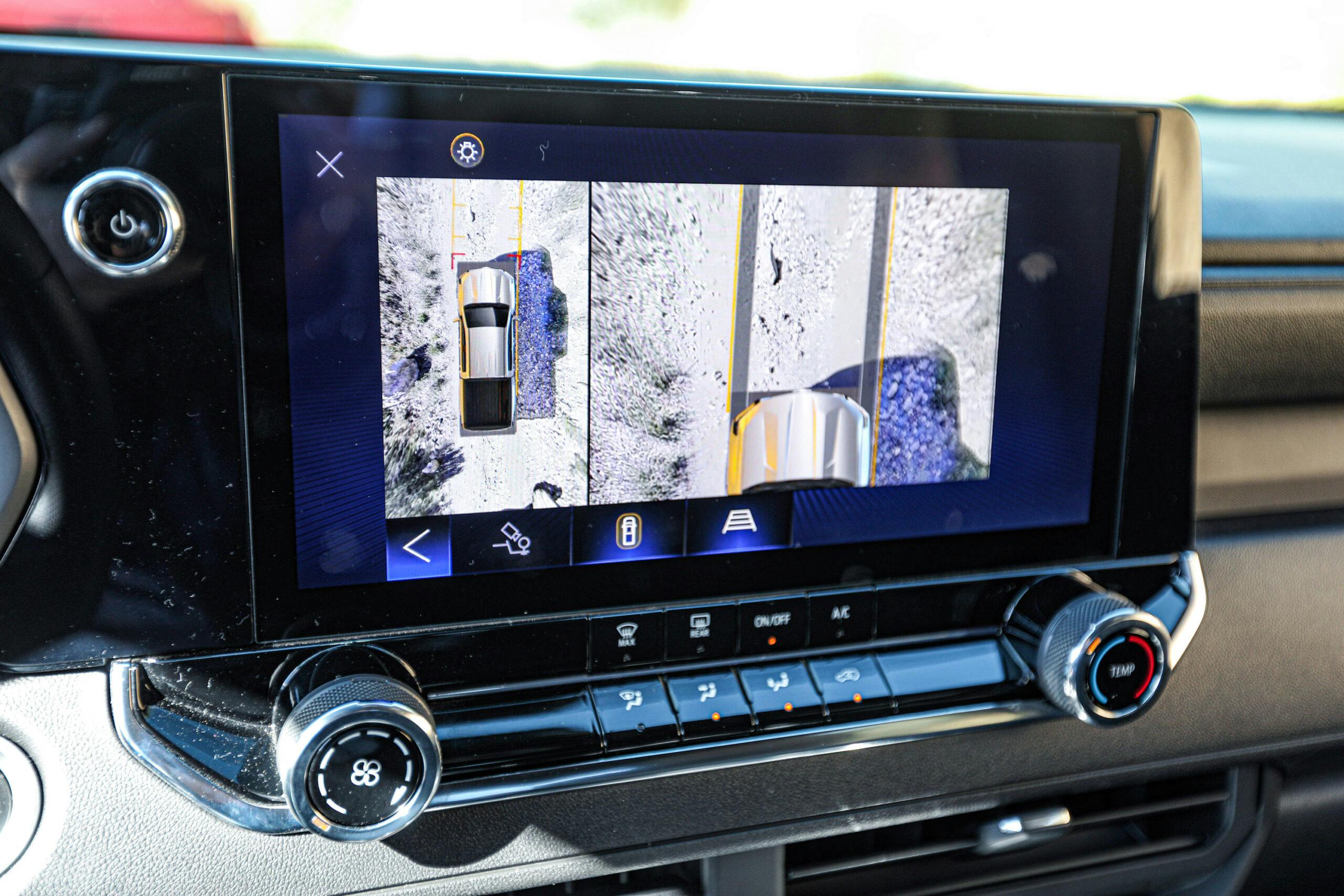
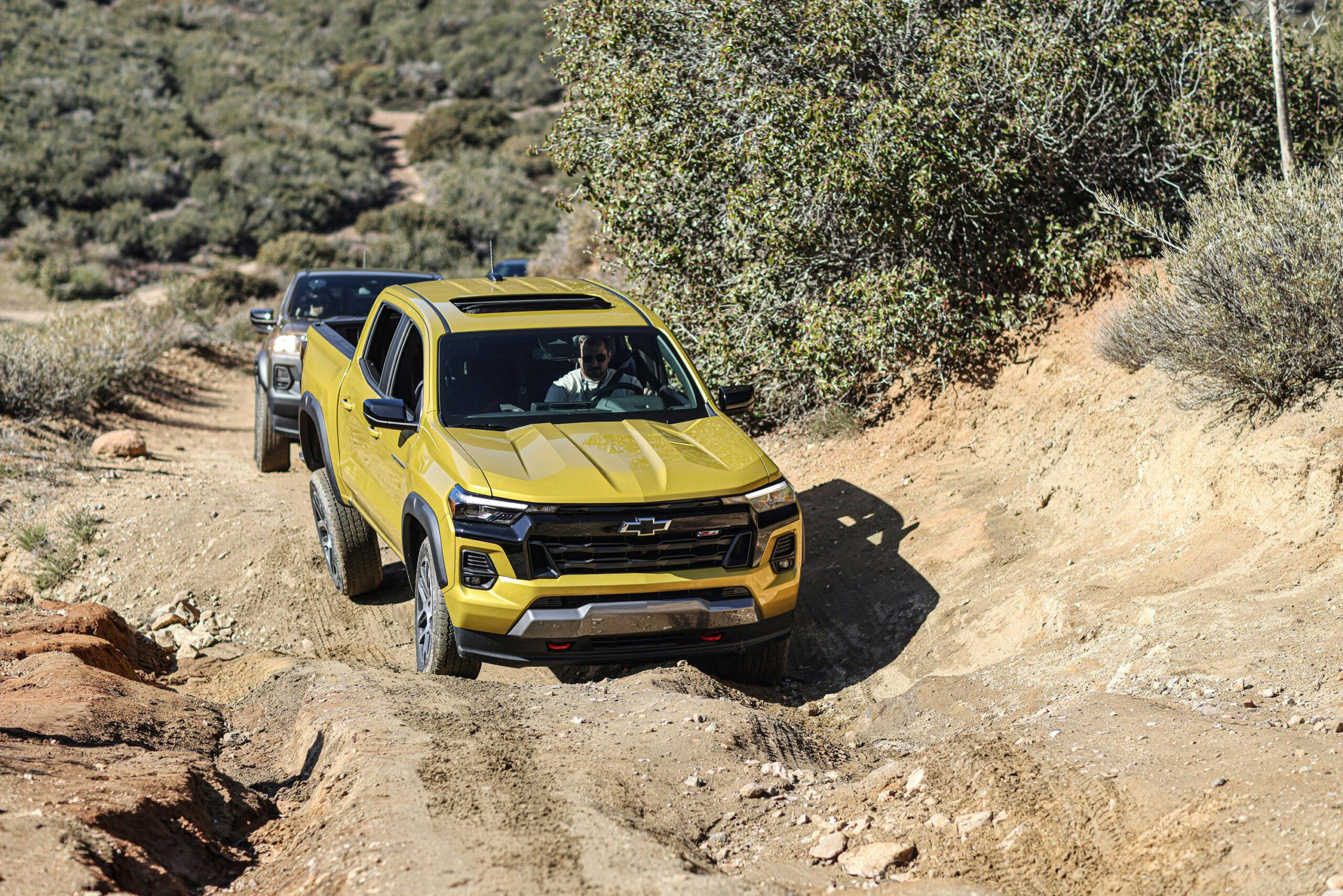


They need a Blazer version.
Midsize? This thing weighs as much as full sized used to. Cost as much as full sized too. My 2000 S10 was only a little over 3200 lbs. (2WD). Good little truck. Couldn’t haul a lot though. Wished I had kept it.
I had a 1999 S-10. Agreed, great little truck, I would like to still have mine, as well.
No V6, No Diesel, No Extend Cab, No sale to me.
Do you own a current Colorado extended cab diesel?
They need to fire the designers for this excuse of an ugly truk. Like the brand they are no longer Chevrolet that are something else that you would find in europe or some other asian country. Way too much plastic too .
I had planned on keeping my 2017 Diesel Colorado for a long time but it cost me $3200 in repairs in the last year to the DPF system and GM refused to offer any assistance, even though this is known problem with the Colorado and Silverado diesels. Also, my truck sat at the dealership for a month because they could not get the parts and then the next repair, 8 months later, they told me the same thing and the truck would be down for another month. Luckily, I work part time for Advance Auto Parts and was able to get the AC Delco part from one of our suppliers in 2 days and took it to the dealership and they fixed the truck.
Chevy sent me all the previews and promos on the new Colorado and was planning on buying one until I found out you cannot get a 6 foot bed. I use my truck as a truck and I hall more than some bags of mulch and I find it ridiculous that you cannot get a 6ft table in the bed without putting the tailgate down. The new Colorado seems more aimed at off-roading people then actual truck people who use them for work or doing home improvements or hauling.
I just traded in my 2017 Colorado after it left me stranded again on Xmas Eve. I purchase a 2023 Tacoma because I could get 6ft bed and the reliability of Toyota. Hopefully it will last me a long time.
Got 42 bags of mulch in my Canyon short bed.
Those crew cabs are really nice, but what about those of us who don’t need a truck like that. A standard cab works fine for me, room enough for me and the dog.
How ’bout the sight line over the hood. What size ladder does this one need to mount up? I guess a few hight challenged pedestrians is worth the bad ass look. And don’t get me started about those who whine about gas prices for what generally becomes a daily commuter. Not looking at you working contractors.
*height
I really like the exterior design of the new Colorado but the interior has way too much cheap looking plastic for a $50 k vehicle. (Z-71) One design feature that seems very odd is the flattened out spot on the plastic wheel arches !! Does this have any function ??
Any wonder why it’s second place to Tacoma? The lack of an access cab with a 5-6 foot bed is only one reason.
The “problem” with control stalks and dials is they involve design, parts and assembly steps which cost far more than adding code to firmware. The screen is one device with two connectors, fits a wide variety of products and yet is capable of infinite functions. So many so easily, manufacturers keep adding “functions” that no one wants.
The comnebt about the torque meeting the Gladiator’s Ecodiesel V6 is incorrect. The Ecodiesel produces more torque at 442 ft-lbs vs the 430 ft-lbs of the Chevy. Still, Chevy, thats pretty good for a gas V6 turbo. My only worry would be that the dealer forgets to flash the ECU and I pay for an HO but get the middle V6. I would just rather have it be HO from the FACTORY. You know that “mistakes” and downright theft of the customer’s money will occur from Chevy. Hey Chevy – do the flash at the FACTORY or just have a hotter ECU that you put in the HO trucks. Simple.
The comnebt about the torque meeting the Gladiator’s Ecodiesel V6 is incorrect. The Ecodiesel produces more torque at 442 ft-lbs vs the 430 ft-lbs of the Chevy. Still, Chevy, thats pretty good for a gas V6 turbo. My only worry would be that the dealer forgets to flash the ECU and I pay for an HO but get the middle V6. I would just rather have it be HO from the FACTORY. You know that “mistakes” and downright theft of the customer’s money will occur from Chevy. Hey Chevy – do the flash at the FACTORY or just have a hotter ECU that you put in the HO trucks. Simple. Just do it, Chevy! I probably wouldn’t buy one just because I would always wonder if I had 430 lb-ft or not. Guess I could hopefully feel it. I have a 2022 Ram 1500 with the Ecodiesel and 480 Lb-ft and you can DEFINITELY feel that torque and low end grunt. The Ram Ecodiesel makes more torque than the Jeep Ecodiesel because it has a larger airbox, more radiator (better cooling), and a much larger exhaust. After all, it’s a full size truck. Mt Ram has the 3.92 rear gears to boot so it’s VERY fun to drive. It feels like you have a 440 V8 under the hood but get 27 MPG on the highway. Awesome.
GM twins outsold F150 in 2020, 2015?… probably a few other times since 77 (when the Ford streak of “best selling truck” began). The internet doesn’t want to easily give me the numbers to compare for some reason.
In Canada, the twins were split between two dealership networks and sales were not that different. Why USA light trucks haven’t all been Silverados for the last 30+ years eludes me… keep the GMC for the 3/4 ton and up stuff. Move Denali into Cadillac, etc.
The Tacoma sells like hotcakes because (and same goes for 4Runner & Lexus GX) it’ll run for 300K miles without an issue. Ford, Chevy, Ram? Not so much. It DOES appear to be the same size as a 1980s full size, then again, a modern Civic is bigger than an old Accord, a ’23 MB C-class is as big as an ’03 E-class, and even the once-tiny RAV4 and CR-V have morphed into almost 2 ton family haulers. Heck, the ‘tiny’ Maverick is bigger than my old 1990 Ford Ranger (that had a much bigger, but much weaker engine). And some lament the lack of a 6-foot bed (or an OMG 8-footer!) rest assured GM would offer it if demand was high enough to make a profit. As for price… it is what it is. The $12,000 MSRP us Gen Xers remember of the truck we wanted while in high school will seem SUPER ridiculously low to our grandkids. $50K for a modern, powerful family hauler that can do everything this vehicle can, while protecting its occupants in a way NASCAR could only imagine 20 years ago is pretty cheap IMHO.
My uncles Chevy just went 350,000 with only a water pump and alternator several sets of brake pads and oil changes.
My buddies Toyota rusted in half with less than 100,000 miles. Frame broke in half.